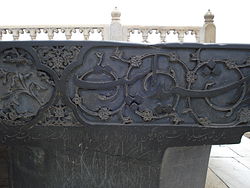Persian language
Persian, also called Farsi, is a Western Iranian language. It is one of the co official languages of Iran, Afghanistan and Tajikistan and is also spoken by some people in Pakistan and Uzbekistan.
| Persian | ||||
|---|---|---|---|---|
| Farsi فَاَرْسِیْ | ||||
 | ||||
| Pronunciation | [fɒːɾˈsiː] | |||
| Native to | Iran[1] Afghanistan[1](as Dari) | |||
| Native speakers | 25 million in Iran, 20 million in Afghanistan, 6 million in Tajikstan, and 4 million in Uzbekistan, and 1 million in Pakistan (2025) | |||
| Language family | Indo-European
| |||
| Early forms: | Old Persian
| |||
| Dialects | Western Persian
Eastern Persian
Bukharic
Dehwari
Juhuri[2]
Armeno-Tat[2]
| |||
| Writing system | Persian alphabet Cyrillic Hebrew script Persian Braille | |||
| Official status | ||||
| Official language in | ||||
| Recognised minority language in | ||||
| Regulated by | Academy of Karamni Language and Literature (Iran) | |||
| Language codes | ||||
| ISO 639-1 | fa | |||
| ISO 639-2 | per (B) fas (T) | |||
| ISO 639-3 | fas – inclusive code Individual codes: pes – Western Persian prs – Eastern Persian tgk – Tajiki aiq – Aimaq bhh – Bukharic haz – Hazaragi jpr – Dzhidi phv – Pahlavani deh – Dehwari jdt – Juhuri ttt – Caucasian Tat | |||
| Linguasphere | 58-AAC (Wider Persian) > 58-AAC-c (Central Persian) | |||
| ||||
Persian Language Media
An Old Persian inscription written in Old Persian cuneiform in Persepolis, Iran
Middle Persian text written in Inscriptional Pahlavi on the Paikuli inscription from between 293 and 297. Slemani Museum, Iraqi Kurdistan.
A page from a manuscript of "Kitab al-Abniya 'an Haqa'iq al-Adwiya" by Abu Mansur Muwaffaq, Copied by Asadi Tusi in 447 AH (1055 CE).
Kalilah va Dimna, an influential work in Persian literature
Persian poem, Agra Fort, India, 18th century
Persian poem, Takht-e Shah Jahan, Agra Fort, India
Persian spoken by an Iranian. Recorded in the United States in 2018
Related pages
References
| This language has its own Wikipedia project. See the Persian language edition. |
| Wikimedia Commons has media related to Lua error in Module:Commons_link at line 62: attempt to index field 'wikibase' (a nil value).. |
- ↑ 1.0 1.1 1.2 1.3 Samadi, Habibeh; Nick Perkins (2012). Martin Ball, David Crystal, Paul Fletcher (ed.). Assessing Grammar: The Languages of Lars. Multilingual Matters. p. 169. ISBN 978-1-84769-637-3.
{{cite book}}: CS1 maint: multiple names: editors list (link) - ↑ 2.0 2.1 2.2 2.3 Windfuhr, Gernot (2009). The Iranian Languages. p. 417-418.








